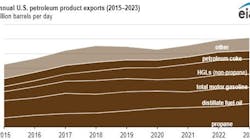Sam Fletcher
OGJ Senior Writer
HOUSTON, Dec. 11 -- The front-month natural gas contract jumped 8.2% Dec. 10 to the highest closing price since mid-January on the New York market after the Energy Information Administration reported the first withdrawal of gas from storage this winter, which proved bigger than expected. Meanwhile, crude continued its longest losing streak in 6 months.
EIA reported the withdrawal of 64 bcf of gas from US underground storage in the week ended Dec. 4, putting working gas levels at 3.77 tcf. Gas stocks are 472 bcf higher than a year ago and 513 bcf above the 5-year average.
“With colder-than-normal weather across the US this week, we expect the withdrawal to more than double next week,” said analysts in the Houston office of Raymond James & Associates Inc. “However, keep in mind we still have 472 bcf more storage than last year, and it will take very cold weather and stronger demand throughout the winter to draw down on this glut.”
They said, “On the oil front, prices tested the $70/bbl mark yesterday, falling marginally and down for the seventh consecutive trading day. However, crude has firmed up just slightly this morning after China reported that its refineries processed a record amount of crude last week and also after the International Energy Agency revised its 2010 oil demand forecast upwards and cut its supply forecast by 0.5%.”
Olivier Jakob at Petromatrix in Zug, Switzerland, said, “West Texas Intermediate had little momentum yesterday as both crude and the euro are sitting on important support lines, the activity was therefore mostly concentrated on reducing some of the long exposure to the product cracks (which by itself provided some support to the crude leg of the cracks).”
Jakob said, “China imported 4.2 million b/d of crude oil in November, which is up 920,000 b/d vs. last year but within the range of recent months. Refinery runs were also very strong and 1.5 million b/d higher than last year. However, according to Reuters, product stocks rose during November due to relatively poor consumption; hence we could expect to see some lower refinery runs during December. Output of electricity was much higher than last year (up 27%) but that is partly due to the very low base of 2008 when industries shut down on the credit crisis. Compared to November 2007, power generation in China [increased] about 17%.”
Jakob added, “In the US, rail freight traffic is down 5.4% vs. last year for the week ending Dec. 5 but is down by 13.3% vs. the same week of 2007.”
Adam Sieminski, chief energy economist, Deutsche Bank, Washington, DC, said, “Production prospects in Iraq and Nigeria are starting to improve. Although we see the potential for the sharpest near-term gains in Nigeria, Iraq is making significant progress on deals with the international oil companies that could double production there over the next 5 years.”
IEA outlook
In its monthly update, IEA’s forecast for global oil demand is virtually unchanged for 2009 at 84.9 million b/d, but it raised its 2010 estimate by 130,000 b/d to 86.3 million b/d.
The Paris-based agency said global oil supply increased by 200,000 b/d in November, with output from the Organization of Petroleum Exporting Countries up 135,000 b/d to 29.1 million b/d—its highest level in a year. “Largely as a result of lower non-OPEC supply prospects for 2010, next year’s call on OPEC is raised by 500,000 b/d to 29 million b/d, compared with 28.7 million b/d in 2009,” IEA said. The agency estimates that OPEC has 6.2 million b/d of spare production capacity.
IEA increased its 2009 forecast for non-OPEC supply by 125,000 b/d to 51.3 million b/d with an upward revision of Russian gas liquids output. “In addition, the end of the quietest US hurricane season since 1997 has contributed to lift this year’s outlook. By contrast, 2010 supply is revised down by 265,000 b/d to 51.6 million b/d, with North American supply now lower,” IEA said.
Jacques H. Rousseau, an analyst at Soleil-Back Bay Research, said, “We view the [IEA] data…as positive for crude oil prices since the demand forecast was raised and the non-OPEC supply forecast was lowered for 2010. Additionally, the IEA updated its medium-term outlook (through 2014) with upward revisions to demand outpacing an increased supply forecast. The IEA expects global crude oil supply-demand fundamentals to tighten in 2011.”
Energy prices
The January contract for benchmark US sweet, light crudes dropped as low as $69.81/bbl in intraday trading before closing at $70.54/bbl Dec. 10 on the New York Mercantile Exchange, down 13¢ for the day. The February contract dropped 23¢ to $72.32/bbl. On the US spot market, WTI at Cushing, Okla., was down 13¢ to $70.54/bbl. Heating oil for December delivery dipped 0.64¢ to $1.90/gal on NYMEX. Reformulated blend stock for oxygenate blending for the same month declined 2.22¢ to $1.84/gal.
The January contract for natural gas jumped 40¢ to $5.30/MMbtu on NYMEX. On the spot market, however, gas at Henry Hub, La., dropped 23¢ to $5.04/MMbtu.
In London, the January IPE contract for North Sea Brent lost 53¢ to $71.86/bbl. Gas oil for December was unchanged at $595.50/tonne.
The average price for OPEC’s basket of 12 benchmark crudes fell $2.27 to $71.43/bbl on Dec. 10.
Contact Sam Fletcher at [email protected].

